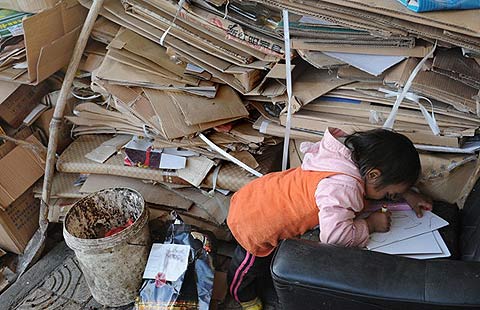Modern landscape of Zhengzhou's ancient heritage
Updated: 2014-10-22 14:04
By James Whitehead(chinadaily.com.cn)
|
|||||||||||
 |
|
Incense rises and waves in the Shaolin Temple air. [Photo by James Whitehead/chinadaily.com.cn] |
The sun glides past the center of the sky. Noon has passed. The light strikes the right corner of the courtyard temple, throwing shade on worshipers kneeling on prayer cushions. Below the steps aligned to the temple, streams of incense wave through the air from the standing sticks of the censer.
Near the Temple entrance, an open area of 200 square meters lies in waiting. Three children take turns running after one another, with wooden swords in hand. This is the Shaolin’s martial arts training square.
Sitting in the courtyard is a centuries old tree, leaning away from the path. Small holes dot the trunk from centuries of finger punching – a practice of Shaolin kung fu.
Decorating the stone skirts and banisters of the temple are chiseled kung fu cartoons, each holding martial arts poses. Despite holding historical artifacts and traditional teaching, the site of Shaolin Temple has been torched, razed and demolished endlessly throughout its deep history. During the warlord period, most of the temple was burned to the ground. Walking round modern-day Shaolin, most of its buildings are no more than 30 years old. Nonetheless, the razing and resilient reconstruction of Shaolin has been a constant through troubled times.
Pagoda forest Outside of the courtyards, a fenced garden springs a shelter of trees. Stone and brick pagodas rise and dip, like varying heights of treetops. First built during the Tang dynasty in 72AD, the forest holds 228 pagodas. Larger level pagodas represent monks with greater achievements. The diversity of shapes makes the forest a gallery of architecture throughout the dynasties.
Related Stories
10th Zhengzhou Int'l Shaolin Wushu Festival kicks off in Dengfeng 2014-10-22 09:32
Barbie fashion show opens in Zhengzhou 2014-08-27 15:27
Xu Beihong and his French masters' paintings come to Zhengzhou 2014-08-15 11:17
'Grand Yellow River Journey' brand to distinguish Sanmenxia and Zhengzhou 2014-07-08 09:08
Zhengzhou Nissan recalls defective SUVs 2014-06-24 09:29
Today's Top News
Premier Li behind row settlement with EU
UK issues milestone RMB bonds
Chinese community leaders in London blast HK protests
Manchester investment portfolio launches in Beijing
Hebei to lower emissions during APEC conference
Step up the battle against HIV/AIDS, urges first lady
PBOC official gets ready 'to assume helm' at ABC
Russian FM sees long standoff with US
Hot Topics
Lunar probe , China growth forecasts, Emission rules get tougher, China seen through 'colored lens', International board,
Editor's Picks

|

|

|

|

|

|





